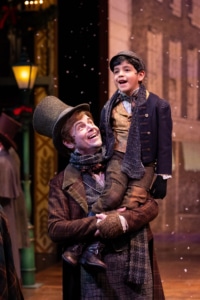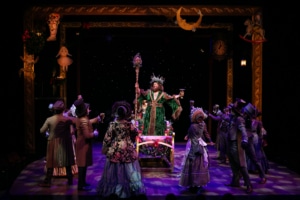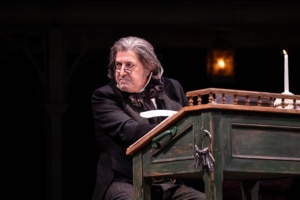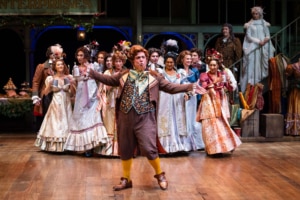DCPA NEWS CENTER
Enjoy the best stories and perspectives from the theatre world today.
Enjoy the best stories and perspectives from the theatre world today.
From the archives: this article was originally published on November 9, 2022
Charles Dickens called his little Christmas book a “carol” after the songs and ballads celebrating the holiday for the birth of Christ. He carried the pretense further by calling the chapters “staves.” “Stave” is an archaic from of the word “staff,” a stanza of a poem or song.

Geoffrey Kent and Benjamin Martinez as Bob Cratchit and Tiny Tim. Photo by Jamie Kraus Photography
Despite the lyrical title, the good-spirited story was written in a dismal, disappointing time for Dickens. At the end of 1843, the writer faced the possibility of decline in popularity and income. His newest novel, Martin Chuzzlewit, had not been well received. His wife Kate was expecting their fifth child. His family pressed him for funds, and his own extravagances in keeping a large house on Devonshire Terrace, London all factored in depleting his earnings.
In the midst of his personal travails, he was plagued by the problem of child labor, so he decided to write a short pamphlet called “An Appeal to the People of England on Behalf of the Poor Man’s Child.” The pamphlet was never written, but Dickens’ sympathies for the poor garnered him an invitation from the Atheneum, a charitable institution for the Manchester working class, to speak at a fund-raising event in October 1843. The audience’s enthusiastic response and their “bright eyes and beaming faces—inspired a desire to try to capture the warm feelings of the people at large.” The inspiration was so strong that on his return to London, Dickens immediately became engrossed in writing his story. He would walk the streets of London late at night alternately weeping and laughing as the story developed.

Topher Embrey as Ghost of Christmas Present and the cast of A Christmas Carol. Photo by Jamie Kraus Photography
At odds with his publishers, Dickens paid for the publishing costs of the book himself and insisted on the lavish design that included a gold-stamped cover and four hand-colored etchings. He also priced the book at five schillings so it would be affordable to nearly everyone.
Published a week before Christmas 1843, the book was an instant sensation; however, due to the high production costs, Dickens’ profits from the work were less than expected. In addition, the work was the victim of pirated editions because of the lack of international copyright laws. Nevertheless, Dickens fought these fraudulent publications while popularizing the work himself by reading it aloud in his public tours.

David Studwell as Ebenezer Scrooge. Photo by Jamie Kraus Photography
The prototype for Scrooge may be found in Dickens’ earlier writing. In the story “The Goblins Who Stole a Sexton,” one of the characters is a bad-tempered gravedigger, Gabriel Grub. On Christmas Eve he can think of nothing better to do than drink beer and dig a grave until he is spirited away by a band of goblins who take him to a cavern where he views panoramas of both rich and poor celebrating Christmas. Through this supernatural medium, Gabriel Grub, like Ebenezer Scrooge, is converted to a new reformed life. Dickens probably derived his miser’s name from the colloquial word “scrooge” which means to crowd or squeeze. In Scrooge’s case, he is described as a “squeezing, grasping, scraping, clutching covetous old sinner.”
Jacob Marley got his surname from Dr. Miles Marley who practiced in Cork Street. He met Dickens at a party, and, knowing that the novelist was interested in unusual names, mentioned that he thought his own name quite remarkable. Dickens reportedly replied: “Your name will be a household word before the year is out.”
The Cratchit family name likely came from “cratch,” an archaic English word for crèche, the manger where Jesus was laid. The name also suggests the scratching of the clerk’s pen.

Matthew Henerson as Fezziwig and the cast of A Christmas Carol. Photo by Jamie Kraus Photography
Tiny Tim was named “Little Fred” in the first edition, but Dickens’ visit to Manchester in 1843 provided another inspiration. His sister Fanny had an invalid son, Harry Burnett, whom Dickens immortalized as both Tiny Tim and the lost boy Paul Domby in Domby and Son. As for Tiny Tim’s illness, it is likely he suffered from distal renal tubular acidosis (type I), a kidney disease that made his blood too acidic, writes Dr. Donald Lewis in the American Journal of Diseases of Children (1992). Therapies such as alkaline solutions were available to treat this condition in 1843, but the Cratchits couldn’t afford them and the symptoms grew worse. Untreated, Tiny Tim would have died within a year, but Scrooge’s newfound generosity provided the funds for the doctors.
Dickens drew heavily on his own experiences to develop the plot. Left alone at school, the young Scrooge takes comfort in the same books loved by the young Dickens. The Cratchits’ humble but exuberant Christmas dinner recalls Dickens’ own celebrations as a child in Camden Town. The author also knew the sorrow of the death of a child, since the young boy experienced the tragedy of losing a brother and sister in infancy.
Dickens preoccupation with children and a specific child is an accusation at a society ignoring a terrible responsibility. A Christmas Carol may be seen as a “serio-comic parable of social redemption.” Scrooge is the symbol of the pursuit of material gain and indifference to human welfare and his conversion is a symbol of that change of heart in society on which Dickens had set his own heart.
The article was excerpted from Inside Out, the DCPA Theatre Company’s study guide.
DETAILS
A Christmas Carol
Nov 21-Dec 28, 2025 • Wolf Theatre
Tickets
